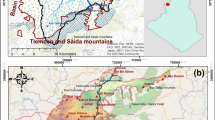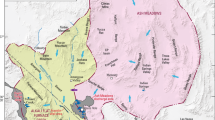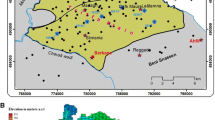Abstract
The study presented in this paper constitutes an initial approach to the problematic task of evaluating the effects of possible climate change on natural water recharge to aquifers. To estimate such effects, a purpose-designed mathematical model termed Estimation of Recharge in Over-exploited Aquifers (ERAS) has been used. It enables to simulate the monthly water recharge to an aquifer, provided that prior knowledge of the exploitation to which it is subjected and the variation caused by these two actions on the piezometric level of the aquifer is available. The basic data required for its application are: precipitation, temperature, groundwater extraction, stored groundwater surface and storage coefficient. The main advantage presented by this model is its independence of the mechanism by which water is displaced through the ground and within the unsaturated zone. The ERAS code was applied to four over-exploited karstic aquifers in Alto Vinalopó (Alicante, Spain) with the goal of generating a synthesized series of values for natural groundwater recharge in each of the aquifers for the 100 years of the twentieth century. Each series thus obtained after being grouped into decades was subjected to statistical processing, which revealed that in every case a logarithmically decreasing trend was present.









Similar content being viewed by others
References
Andreo B, Vías J, López Geta JA, Carrasco Durán JJ, Jiménez P (2004) Aproximación metodológica para evaluar la recarga en acuíferos carbonáticos (Methodological aproximation for carbonatic aquifers recharge assessment). Bol Geol Min 115:211–222
Andreu JM, Delgado J, García-Sánchez A, Pulido-Bosch A, Bellot J, Ortiz Chirino E, de Urbina JM (2001) Caracterización del funcionamiento y la recarga del acuífero del Ventós-Castellar (Alicante) (Ventós-Castellar (Alicante) aquifer recharge and functioning chracterization). Rev Soc Geol Esp 14:247–254
Aragón R, Barba-Romero J, Rodríguez L, Virgos L (1995) Determinación del grado actual de regulación de embalses subterráneos mediante la utilización de modelos de precipitación-escorrentía (Determination of present degree of regulation of groundwater reservoirs through precipitation-runoff models) Paper presented at the VI simposio de hidrogeología, Sevilla 23:97–111
Armayor JL, De la Orden JA, Murillo JM (2001). Artificial recharge as a technique to alleviate the overexploitation of small aquifers located on the Spanish Mediterranean coast. Paper presented at the 3rd international conference on future groundwater. Resources at Risk, Lisbon, p 8
Beekman HE, Xu Y (2003) Review of groundwater recharge estimation in arid and semi-arid Southern Africa. In: Xu Y, Beekman HE (ed) Groundwater recharge estimation in Southern Africa. UNESCO, Paris, pp 3–18
Bekesi G, McConchie J (1999) Groundwater recharge modelling using the Monte Carlo technique, Manawatu region, New Zealand. J Hydrol 224:137–148
Bouraoui F, Vachaud G, Chen T (1998) Prediction of the effect of climatic changes and land use management on water resources. Phys Chem Earth 23:379–384
Brunet M, Aguilar E, Saladie O, Sigró J, López D (1999) Variaciones y tendencias contemporáneas de la temperatura máxima, mínima y amplitud térmica diaria en el NE de España (Variations and contemporary trends of maximum and minimum temperature and daily termal range for NE Sapin) In: Oikos-Tau y Asociación Española de Climatología (eds) La Climatología española en los albores del siglo XXI. Barcelona, Serie A, 1:103–112
Burke S (1995) Land surface parameterization: regionalised versus distributed approach to groundwater recharge. Phys Chem Earth 20:331–337
Capdevila AS, Valdés JB, González Pérez J, Baird K, Mata LJ, Maddock T (2007) Modeling climate change impacts—and uncertainty—on the hydrology of a riparian system: the San Pedro Basin (Arizona/Sonora). J Hydrol 347:48–66
Capó E, Llasat MC, Quintas L (1999) Caracterización pluviométrica espacio temporal de España dentro del proyecto AMHY/FRIEND (Spatial and temporal pluviometric characterization of Spain within the AMHY/FRIEND Project) In: Oikos-Tau y Asociación Española de Climatología (eds) La Climatología española en los albores del siglo XXI. Barcelona, Serie A, 1:123–130
Chen Z, Grasby SE, Osadetz KG (2002) Predicting average annual groundwater levels from climatic variables: an empirical model. J Hydrol 260:102–117
Chen Z, Grasby SE, Osadetz KG (2004) Relation between climate variability and groundwater levels in the upper carbonate aquifer, southern Manitoba, Canada. J Hydrol 290:43–62
Conrad J, Nel J, Wentzel J (2004) The challenges and implications of assessing groundwater recharge: a case study - northern Sandveld, Western Cape, South Africa. Water SA 30:75–81
Custodio E (1998) Recarga a los acuíferos: aspectos generales sobre el proceso, la evaluación y la incertidumbre (Aquifer recharge: general issues on the process, assessment and uncertainity). Bol Geol Min 109:13–29
DGOHCA-ITGE (1998) Programa de ordenación de acuíferos sobreexplotados/salinizados. Formulación de estudios y actuaciones (Inventory program for overexploited/salinizated aquifers. Studies and management options) Dirección General de Obras Hidráulicas y Calidad de las Aguas-Instituto Tecnológico Geominero de España, p 66
Eckhardt K, Ulbrich U (2003) Potential impacts of climate change on groundwater recharge and streamflow in a central European low mountain range. J Hydrol 284:244–252
Elías F, Giménez R (1965) Evapotranspiraciones potenciales y balances de agua en España (Potential evapotranspirations and water budgets in Spain) Ministerio de Agricultura. Dirección General de Agricultura, Madrid, p 293
González-Hidalgo JC, De Luis M, Raventós J, Sánchez JR (2001) The spatial and temporal structure of precipitation trends in the Valencia Region (eastern Spain) over the second half of the 20th century. In: Brunet M, López D (eds) Detecting and modelling regional climate change. Springer-Verlag, New York, pp 175–189
Heredia J, Murillo JM (2002) Balance hídrico y estimación de la recarga mediante modelación numérica en pequeñas cuencas del sector suroriental de la isla de Gran Canaria. Paper presented at the XI international congress on industry, mining and metalurgic, Zaragoza, p 19
Hiscock K, Sparkes R, Hodgson A, Martin JL, Taniguchi M (2008) Evaluation of future climate change impacts in Europe on potential groundwater recharge. Geophys Res Abstr, vol 10
Iglesias A (1984) Diseño de un modelo para el estudio de descargas de acuíferos. Modelo Meda (Designing a model for aquifer discharge studies). Bol Geol Min 95:52–57
Jirkama MI, Sykes JF (2007) The impact of climate change on spatially varying groundwater recharge in the grand river watershed (Ontario). J Hydrol 338:237–250
Krüger A, Ulbrich U, Speth P (2001) Groundwater recharge in Northrhine-Westfalia predicted by a statistical model for greenhouse gas scenarios. Phys Chem Earth 26:853–886
Labajo JL, Piorno A (2001) Regionalization of precipitation in Castilla and Leon. Analysis of its temporal behaviour. In: Brunet M, López D (eds) Detecting and modelling regional climate change. Springer-Verlag, New York, pp 163–174
Lee JY, Lee KK (2000) Use of hydrologic time series data for identification of recharge mechanism in a fractured bedrock aquifer system. J Hydrol 229:190–201
Lee CH, Chen WP, Lee RH (2006) Estimation of groundwater recharge using water balance coupled with base-flow-record estimation and stable-base-flow analysis. Environ Geol 51:73–82
Lerner DN, Issar AS, Simmers I (1990) Groundwater recharge: a guide to understanding and estimating natural recharge. In: IAH (eds) International Contributions to Hydrogeology, vol 8, Heise, Hannover, p 345
López-Rodríguez JJ, Giráldez JV (1997) Evaluación de la modificación de la recarga por cambios en la cobertera vegetal (Assessment on recharge modification due to vegetation cover changes). In: Custodio E, Llamas MR, Samper J (eds) La evaluación de la recarga a los acuíferos en la Planificación Hidrológica. International Association of Hydrogeologists. Spanish Group, Las Palmas de Gran Canaria, 209–227
Marechal JC, Dewandel B, Ahmed S, Galeazzi L, Zaidi FK (2006) Combined estimation of specific yield and natural recharge in a semi-arid groundwater basin with irrigated agriculture. J Hydrol 329:281–293
Martín A, Arjona García-Borreguero J, Hervás Maldonado M, Mera Merino A, Iglesias López A (1992) Aplicaciones informáticas para estudios de descarga de acuíferos. Modelo Meda. Paper presented at the V Simposio de Hidrogeología, Alicante 17:37–48
Martín Machuca M, Virgos L (1995) Modelo matemático del acuífero de Almonte-Marsimas. Paper presented at the VI Simposio de Hidrogeología, Sevilla 19:639–660
Murillo JM (2004) Recarga de acuíferos. Evaluación y análisis de condicionantes técnicos y económicos. Acuífero aluvial del Bajo Guadalquivir. Dissertation, Universidad Politécnica de Madrid, Spain [in Spanish]
Murillo JM, De la Orden JA (1996) Sobreexplotación, alternativas de gestión y evaluación del efecto del cambio climático en la recarga natural del acuífero kimmeridgiense de Cabezón de Oro (Alicante) (Overexploitation, management aoptions and climate change effect on natural recharge to the kimmeridgiense aquifer of Cabezón de Oro (Alicante) assessment) In: Recursos Hídricos en Regiones Kársticas, Vitoria, 73–88
Ortiz López JI, Iglesias Delgado de TE, Hernández Manchado R, De Mera Merino A, Gómez Sánchez M, López Bravo J, Ballester Rodríguez A (2001) Desarrollo de programas para el tratamiento de series hidrológicas y evaluación de aportaciones hídricas subterráneas (HIDROBAS v. 3.0). Paper presented at the VII Simposio de Hidrogeología, Murcia 23:333–341
Peña S, Arcos D (2004) Estimación inicial de la recarga natural vertical para su introducción en modelos de simulación de flujo con la ayuda de sistemas de información geográfica. Paper presented at the Seminario: Sistematización y automatización como herramienta para la gestión del agua, Guanajuato, p 9
Priyantha Ranjan S, Kazama S, Sawamoto M (2006) Effects of climate and land use changes on groundwater resources in coastal aquifers. J Environ Manag 80:25–35
Quereda J, Montón E (1999) La hipótesis de la estabilidad climática en el Mediterráneo español (The climatic stability hypothesis in the Spanish Mediterraneo) In: Oikos-Tau y Asociación Española de Climatología (eds) La Climatología española en los albores del siglo XXI. Barcelona, Serie A, 1:427–438
Ruiz García JM (1999) Modelo distribuido para la evaluación de recursos hídricos (Distributed model for hydrological resources assesment) Ministerio de Fomento, Centro de Estudios y Experimentación de Obras Públicas (CEDEX) (ed) p 245
Samper J, Llorens H, Arés J, García MA (1999) Manual del usuario del programa Visual Balance v. 1.0. Código interactivo para la realización de balances hidrológicos y la estimación de la recarga (Visual Balan v. 1.0 user manual. Interactive code for hydrologic budgets and recharge estimation) ENRESA (ed) Publicación Técnica número 05/99, p 134
Samper FJ, García Vera MA, Pisani B, Varela A, Losada JA, Alvares D, Espinha Marques J (2005) Aplicación de modelos hidrológicos y sistemas de información geográfica para la estimación de los recursos hídricos: GIS-VISUAL-BALAN y su aplicación a cuencas atlánticas en España (Valiñás) y Portugal (Serra da Estrela). Paper presented at the VII Jornadas de Investigación en la Zona no Saturada del Suelo, A Coruña, 274–296
Scibek J, Allen DM (2006) Comparing modelled responses of two high-permeability, unconfined aquifers to predicted climate change. Glob Planet Change 50:50–62
Tapia FO, Mora FE (2004) The Information Society: new horizons for science. Paper presented at the 19th international CODATA conference, Berlín, p 13
Acknowledgments
The authors thank Diputación Provincial de Alicante and Comunidad de Usuarios del Vinalopó for their never-failing willingness to provide the data required to carry out the present study. This paper was developed at the Geological Survey of Spain.
Author information
Authors and Affiliations
Corresponding author
Rights and permissions
About this article
Cite this article
Aguilera, H., Murillo, J.M. The effect of possible climate change on natural groundwater recharge based on a simple model: a study of four karstic aquifers in SE Spain. Environ Geol 57, 963–974 (2009). https://doi.org/10.1007/s00254-008-1381-2
Received:
Accepted:
Published:
Issue Date:
DOI: https://doi.org/10.1007/s00254-008-1381-2




